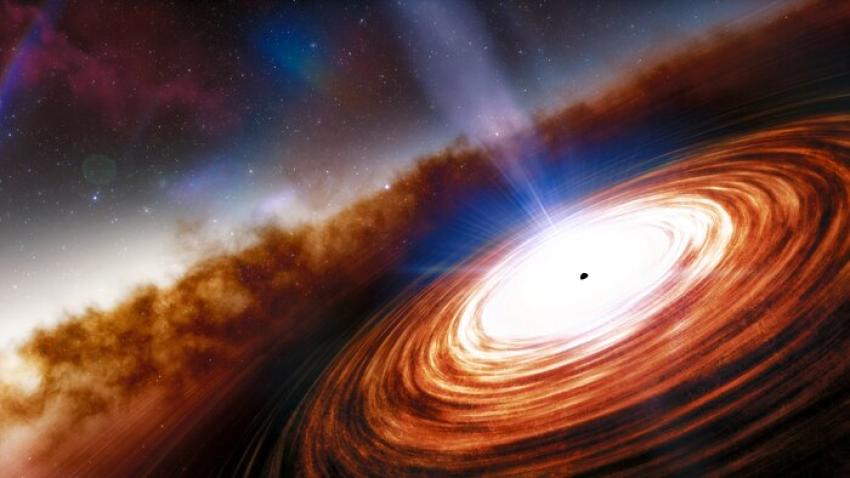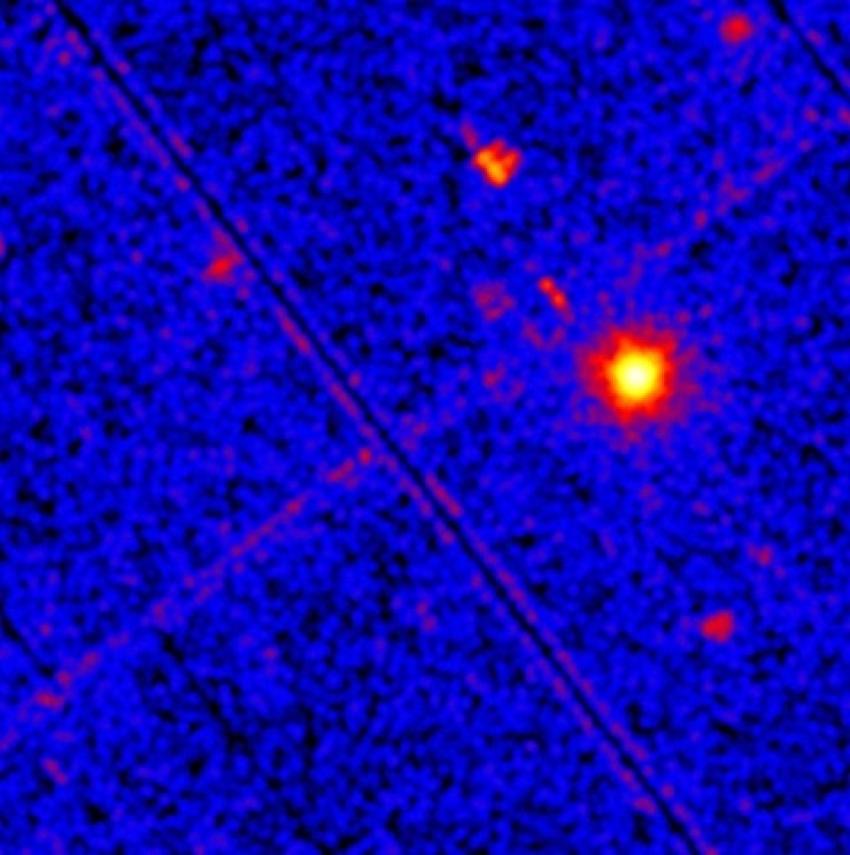Researchers have observed the X-ray emission of the most luminous quasar seen in the last 9 billion years of cosmic history, known as SMSS J114447.77-430859.3, or J1144 for short. The new perspective sheds light on the inner workings of quasars and how they interact with their environment. The research is published in Monthly Notices of the Royal Astronomical Society.
Hosted by a galaxy 9.6 billion light years away from the Earth, between the constellations of Centaurus and Hydra, J1144 is extremely powerful, shining 100,000 billion times brighter than the Sun. J1144 is much closer to Earth than other sources of the same luminosity, allowing astronomers to gain insight into the black hole powering the quasar and its surrounding environment. The study was led by Dr Elias Kammoun, a postdoctoral researcher at the Research Institute in Astrophysics and Planetology (IRAP), and Zsofi Igo, a PhD candidate at the Max Planck Institute for Extraterrestrial Physics (MPE).
Quasars are among the brightest and most distant objects in the known universe, powered by the fall of gas into a supermassive black hole. They can be described as active galactic nuclei (AGN) of very high luminosity that emit vast amounts of electromagnetic radiation observable in radio, infrared, visible, ultraviolet and X-ray wavelengths. J1144 was initially observed in visible wavelengths in 2022 by the SkyMapper Southern Survey (SMSS).
For this study, researchers combined observations from several space-based observatories: the eROSITA instrument on board the Spectrum-Roentgen-Gamma (SRG) observatory, the ESA XMM-Newton observatory, NASA’s Nuclear Spectroscopic Telescope Array (NuSTAR), and NASA’s Neil Gehrels Swift observatory.
The team used the data from the four observatories to measure the temperature of the X-rays being emitted from the quasar. They found this temperature to be around 350 million Kelvin, more than 60,000 times the temperature at the surface of the Sun. The team also found that the mass of the black hole at the quasar’s centre is around 10 billion times the mass of the Sun, and the rate at which it is growing to be of the order of 100 solar masses per year.
The X-ray light from this source varied on a time scale of a few days, which is not usually seen in quasars with black holes as large as the one residing in J1144. The typical timescale of variability for a black hole of this size would be on the order of months or even years. The observations also showed that while a portion of the gas is swallowed by the black hole, some gas is ejected in the form of extremely powerful winds, injecting large amounts of energy into the host galaxy.
Dr Kammoun, lead author of the paper, says “We were very surprised that no prior X-ray observatory has ever observed this source despite its extreme power.”
He adds, “Similar quasars are usually found at much larger distances, so they appear much fainter, and we see them as they were when the Universe was only 2-3 billion years old. J1144 is a very rare source as it is so luminous and much closer to Earth (although still at a huge distance!), giving us a unique glimpse of what such powerful quasars look like.”
“A new monitoring campaign of this source will start in June this year, which may reveal more surprises from this unique source”.
Media contacts
Gurjeet Kahlon
Royal Astronomical Society
Mob: +44 (0)7802 877700
press@ras.ac.uk
Dr Robert Massey
Royal Astronomical Society
Mob: +44 (0)7802 877699
press@ras.ac.uk
Science contacts
Dr Elias Kammoun
Research Institute in Astrophysics and Planetology (IRAP), Toulouse
ekammoun@irap.omp.eu
Zsofi Igo
Max Planck Institute for Extraterrestrial Physics (MPE)
zigo@mpe.mpg.de
Further information
The research appears in ‘The first X-ray look at SMSS J114447.77-430859.3: the most luminous quasar in the last 9 Gyr’, Kammoun et al., Monthly Notices of the Royal Astronomical Society, in press.
Notes for editors
The Royal Astronomical Society (RAS), founded in 1820, encourages and promotes the study of astronomy, solar-system science, geophysics and closely related branches of science. The RAS organises scientific meetings, publishes international research and review journals, recognises outstanding achievements by the award of medals and prizes, maintains an extensive library, supports education through grants and outreach activities and represents UK astronomy nationally and internationally. Its more than 4,000 members (Fellows), a third based overseas, include scientific researchers in universities, observatories and laboratories as well as historians of astronomy and others.
The RAS accepts papers for its journals based on the principle of peer review, in which fellow experts on the editorial boards accept the paper as worth considering. The Society issues press releases based on a similar principle, but the organisations and scientists concerned have overall responsibility for their content.
Keep up with the RAS on Twitter, Facebook, Instagram, LinkedIn, and YouTube.



